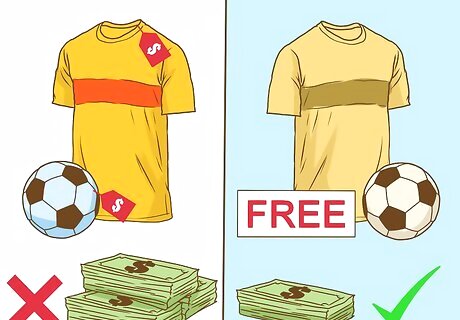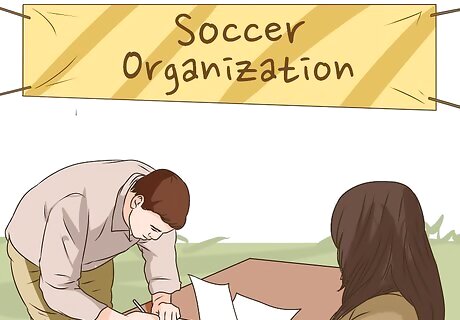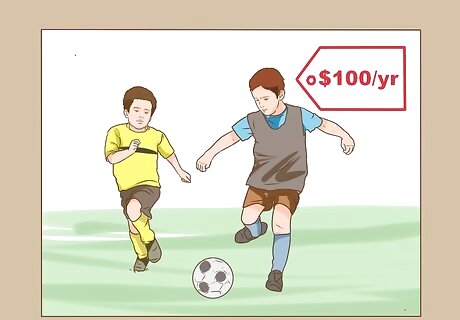
views
Saving Money on Sports

Buy secondhand equipment. If your child is playing a sport, the equipment costs can add up quickly. Visit your local secondhand store or check online purveyors of used goods like eBay to pick up some more affordable equipment for your child. Garage sales are also a great source for locating secondhand equipment. You might be able to find gently used: baseball bats tennis rackets ice skates hockey sticks

Rent equipment. If possible, rent equipment from sporting goods stores or from the program directly. You might also be able to rent equipment from certain online sites. Look for opportunities to rent equipment and save money. Renting uniforms, shoes, and so on is a good idea for children who are still growing, since they might only get limited use out of their equipment before outgrowing it.

Sign up for community sports programs. Community sports programs are typically more cost-effective than private sports leagues or lessons. Plus, community sports programs often provide your child with the opportunity to participate in a variety of sports, rather than just a single sport. Get in touch with the community sports division in your local municipality for more information about signing your child up for your community sports league.

Choose the least expensive option. Suppose your child is interested in sports and they enjoy soccer, hockey, and baseball equally. But if the signup fees and equipment costs for one are less than the others, encourage them to sign up for the least expensive after-school activity. Ensure your child is on board with your decision. Don’t sign them up for an after-school activity that they aren’t interested in simply because it is less expensive than the others. Look for inexpensive options even within the same after-school activity. For instance, if your child wants to join the soccer team, but one team requires that each player must buy their own jersey and ball while another provides them, encourage your child to join the team that doesn’t require members to own their own jerseys and gear.
Taking a Leadership Role

Lead after-school activities yourself. Most people think of after-school activities as a club, sports team, or other centrally organized operation that your child has to sign up for. However, one of the most cost-effective ways to provide after-school activities for your child is to organize the activities yourself. Take your child to free (or inexpensive) events and cultural attractions like museums, zoos, and botanical gardens. If you want to stay closer to home, identify arts and crafts you think your child might enjoy and obtain the necessary materials. Visit your local library and check out some arts and crafts books with ideas for activities you and your child might enjoy doing together. Obtain arts and crafts materials on sale, if possible. Allow your child to invite a few friends to join them if they wish. Volunteer with your child at your local soup kitchen or homeless shelter. You could also take your child on a nature walk with local conservation or bird-watching societies.

Join the organization. Working within the organization will give you an opportunity to look for and implement cost-saving measures not only for your own child, but for everyone who participates in the after-school activity. If possible, get a job or even a volunteer position within the organization that runs the after-school activity your child is interested in. Contact the organization and inquire as to whether they have any jobs available. If they don't, follow up by asking about taking on a volunteer role. Once you join the organization, you could: solicit local businesses and wealthy philanthropists for charitable donations to cover the kids’ costs haggle with equipment manufacturers for lower prices identify sources of local, state, or federal grants for your after-school programs locate venues that offer better rates for renting space find other cost-saving measures (like energy efficiency) and pass the savings on to the children and their families in the form of reduced registration fees

Work to cover administrative fees. Many kids’ organizations and after-school programs require membership dues or sign-up fees. But parents are often allowed to contribute their labor in an amount equivalent to the fees that need to be covered. If you have time to work for the after-school program, get in touch with them and see if you can reach an agreement. You might be able to file paperwork, work as an event monitor, help other children sign up, or answer phone calls or emails as part of an effort to get program fees partially reduced or waived entirely.
Signing Up for Activities

Check with your local parks. State and municipal parks often offer a variety of affordable after-school activities, including nature walks, horticultural classes, and educational programming relating to the biology of local plants and animals. These programs are often free or steeply discounted. Contact your local parks and recreation department for more information.

Look for free activities. Public libraries often host multiple free after-school activities for kids of all ages. Your child might be able to participate in book clubs, movie nights, and clubs for both board games and videogames. Police departments in some cities also offer free activities, including athletic and recreational programming. Contact your local library, police station, or other community organization – or check their events calendar online – for information about what sorts of after-school activities they offer.

Register early. Early registration can often translate to a savings of 10% to 30% off the regular registration fee. Contact the sports league or organization of your child’s choice and inquire when the early registration period begins, as well as what the early-registration discount is at each stage. Sign up as soon as possible if early registration is allowed.

Apply for sponsorships. Local businesses sometimes offer sponsorships or scholarships for children who want to participate in after-school activities – especially after-school sports programs – but whose families are facing financial challenges. The organization that runs the after-school activity might itself offer sponsorships or financial assistance for kids whose families cannot afford the fees. Talk to the organizers of the after-school activity your child is interested in to find out more about what sorts of financial assistance is available. If you demonstrate a financial need, your child might be able to participate in the after-school activity without paying any fees. Write a sincere thank-you note to the business or organizational leaders who assist you and your child financially.

Limit the number of activities your child engages in. Tell your child to choose just one or two of their favorite after-school activities each year in order to save money. Or, instead of limiting their after-school activities to a discrete number of activities, you could limit their activity to a certain dollar range. For instance, you might decide not to spend more than $100 per year on after-school activities. The number of activities you choose to limit your child to depends on their ability to balance their activities, academic, and social lives. If your child continues to remain stress-free and do well academically despite participating in several activities after school, don’t discourage them from participating in their activities. The financial limit you place on your child’s after-school activities, likewise, depends on your family’s financial situation.



















Comments
0 comment